About the Eurasier Breed
The Eurasier is relatively new to North America, but is quite popular in its native Germany where it is known as the "ideal house dog".
Breed Details
- Physical
- Socialization
- Sex Differences & Grooming
- Lifespan & Health
- Coat
- Other Breed Information
- References
Physical
It is a medium sized spitz breed with a thick woolly undercoat, and soft, rich, medium length outer coat in various colors, ranging from fawn or beige to mahogany red, and wolf-gray to black. Its bushy tail curls proudly over its back, and the dark, almond-shaped eyes portray an expression of intelligence. Interestingly, the Eurasier can also have a blue-black or spotted tongue.
Socialization
The Eurasier is a clean and quiet dog with a tender and affectionate nature, and is well suited to family life. It is loving and tolerant with children. And, while hardy enough to live outside, Eurasiers must be allowed to share their owner's home and reside indoors! If not included in everyday family activities their spirit will be broken; they will suffer from loneliness, and will pine away if kept outdoors or in a kennel.
The Eurasier is loyal to all members of the family. However, it is reserved and distrustful of strangers, and paired with a natural instinct to protect, it thus makes an excellent watchdog. It barks an alarm only when necessary, and when provoked emits a deep, wolf-like growl.
Eurasiers are highly intelligent, alert and quick-witted; very easily trained with an overwhelming desire to please. They are extremely sensitive to harsh words or discipline and respond best to reinforcement of good behaviours. They can be quite mischievous during the first few months of puppy hood, but become more reserved as they mature. Nevertheless, adult dogs still can be extremely playful.
Sex Differences & Grooming
Male Eurasiers range in size from 20-23 inches at the withers (52-60 cm) and can weigh from 50-70 pounds (23-32kg). Females are 19-22 inches (48-56cm) and weigh 40-57 pounds (18-26 kg). Eurasiers do not have a natural "doggie" odor, and if kept in clean surroundings, a bath 2-3 times a year is all that's required. Their coat does require regular weekly brushing, although that could increase to daily grooming during seasonal shedding periods. Exercise needs are met by a daily walk.
Lifespan & Health
Eurasiers will live for 12-15 years. They adapt to all types of environments and residential living (housing, apartments, etc). And they are a healthy breed with few problems. Only those Eurasiers that have a calm, stable temperament and have been certified free of hip dysplasia, patella luxation and congenital eye disease are used for breeding.
Coat
The eurasier's coat changes many times over the course of its life. There are marked colour changes as the dog ages, and periodically, a eurasier will "blow its coat", shedding the majority of its hair in a short span of time. The coat subsequently regrows, but the dog looks very different when the coat is "blown".
Colour Changes
The pictures below show the changes in Aiko's colour as she matures.
-
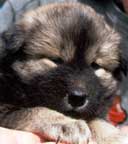
Aiko at 6 weeks -
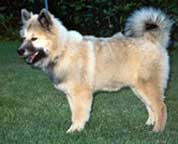
Aiko at 4 months -
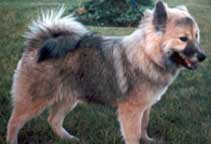
Aiko at 6 months -
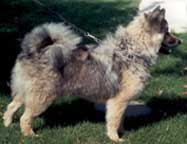
Aiko at 1 year
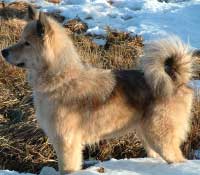
Other Breed Information
Eurasiers were given official breed status by the Canadian Kennel Club (CKC) on June 13, 1995. In June, 2000 Eurasiers celebrated their 40th anniversary. They were initially developed in Weinheim, Germany by crossing a male Chow Chow with a female German Wolfspitz. Only the offspring that exhibited the best characteristics of the two were kept for breeding they were called Wolf-Chow Polar Dogs, and then simply Wolf-Chows. In 1972 these Wolf-Chows were cross-bred for the final time with a Samoyed - the name was changed to Eurasier, and the breed was recognized internationally by the Federation Cynologique Internationale (FCI).
Eurasiers are almost a well-kept secret, as Europeans have been very guarded about letting these dogs leave their countries. Those people privileged enough to own a Eurasier, are rewarded with having a loving companion of flawless character.
References
- Eurasier Heute (Eurasier Today) - Annelie Feder (with English translation)
- Eurasier-Klub e.V. Sitz Weinheim (EKW) Germany
- Zuchtgemeinschaft fur Eurasier (ZG) Germany
- Reader's Digest Book of Dogs (pages 144,145)
- The Atlas of Dog Breeds of the World (Wilcox & Walkowicz)
- Mini Atlas of Dog Breeds (DePrisco & Johnson)
Compiled by: Wayne Nelson (SunWolf Reg'd)
